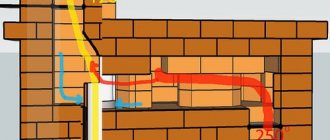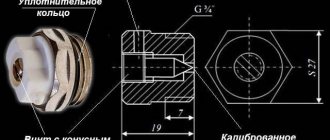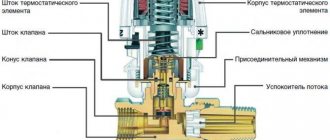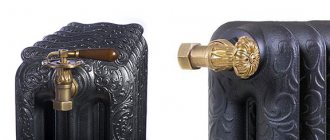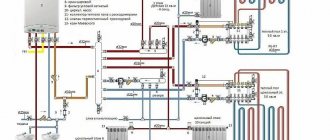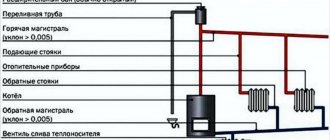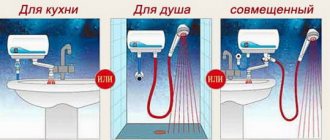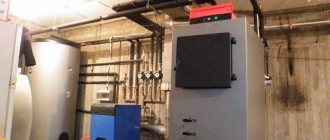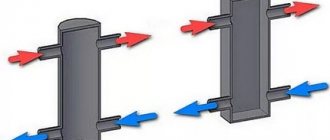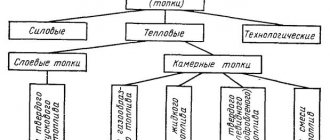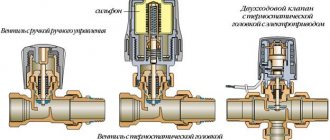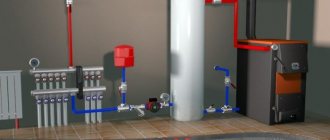How to clean an aluminum heater
Flushing the heating device is carried out to remove lime deposits from the inner surface of the radiator or to prevent their formation.
Preventative flushing should be carried out once a year.
Let's look at how to wash an aluminum radiator effectively. There are several washing methods. The choice of one method or another depends on the amount of deposits. The most commonly used chemicals are acids and alkalis. But when choosing such a tool you need to be extremely careful. Because some substances can have a negative effect on the battery material. The advantage of this method is that the heating system does not need to be disassembled. There is also a hydrodynamic method for flushing the battery. The bottom line is that scale is removed with a thin stream of water. Water is supplied under a certain pressure using special nozzles.
To flush the heating system, it is better to contact a specialist. He will choose the most suitable method and carry out the procedure competently and efficiently.
- How to fill water into an open and closed heating system?
- Popular floor-standing gas boiler made in Russia
- How to properly bleed air from a heating radiator?
- Expansion tank for closed heating: device and principle of operation
- Gas double-circuit wall-mounted boiler Navien: error codes for malfunctions
Recommended reading
Which heating radiators are best to connect in an apartment? Heating radiators - models and selection features Panel heating radiators: options and parameters Non-traditional steel heating radiators: their quality and classification
2016–2017 — Leading heating portal. All rights reserved and protected by law
Copying site materials is prohibited. Any copyright infringement will result in legal liability. Contacts
How do aluminum radiators work?
According to the design, there are one-piece and sectional versions . The first is made from profile plates made using extrusion technology, which increases plasticity.
The resulting parts are welded, creating a complete battery. This makes it durable. The inner side is first coated with a polymer, which reduces the chance of leakage.
Sections are made one at a time , then connected. Pure metal is rarely used: aluminum is alloyed with silicon, zinc, and sometimes titanium . These substances increase strength and reduce the risk of rupture and corrosion. Silicates are used as a sealant. Like solid ones, the inside of the device is coated with a special liquid to protect against high pressure.
According to the manufacturing method, aluminum radiators are divided into three types: casting, extrusion and anodized. Among the technical characteristics, the following are important:
- The working pressure should be in the range of 10-15 atm. In apartment buildings, the indicators are much higher, so the use of aluminum devices in them is not recommended. The test one is twice as much as usual, but it’s better to have a reserve.
- The battery power is 82-212 watts , depending on the dimensions.
- The maximum heating of the coolant should not exceed 120 °C .
- Section weight - 1-1.5 kg . Volume - 0.25-0.46 liters .
- The center distance depends on the height and ranges from 20 to 80 cm , sometimes exceeding it.
The parameters of each aluminum device may differ, but are necessarily indicated in the technical data sheet of the product .
Advantages of aluminum radiators:
- Compactness and low weight make installation easy and do not require powerful fasteners.
- High heating rate , good heat transfer.
- Long service life , although shorter than cast iron.
- The short length of the sections will allow you to choose one suitable for a specific room. And also, by dividing the device into parts, it is possible to create a system without excess heating.
- Aluminum is easy to process , which allows the creation of designer devices.
- Good protection from external damage . The radiator is very difficult to damage or break with a physical blow, but it is quite easy to bend.
- Relative cheapness of metal.
Among the disadvantages are:
- Poor protection against corrosion , which damages the device during operation. Aluminum is an active substance that easily interacts with oxygen. Oxidation will destroy the protective layer as hydrogen gas is released during the reaction.
- The need to apply a polymer coating to prevent rupture and protect against discharge.
Sectional design of an aluminum battery
If you look at the device from above or below, the collectors will become visible. They create horizontal channels for transporting liquid. The bottom one collects dirt, scale, and other solid particles, which helps avoid clogging the entire device. A special valve is provided for removal.
Attention! The main disadvantage is frequent leaks at the joints.
A cross-sectional view of an aluminum radiator is shown in the picture.
Photo 1. Internal structure of an aluminum heating radiator. The body is made of aluminum, and there is a copper tube running inside.
Aluminum battery device
When considering the design of an aluminum heating radiator, it should be noted that the design of the battery can be solid or sectional.
A sectional aluminum heater consists of 3-4 separate sections. As a rule, titanium, silicon, and zinc are added to aluminum. These metals make the product stronger and more resistant to tearing and corrosion. All sections are connected to each other using a threaded connecting element. Silicone gaskets are used to seal the connection. The radiators have a polymer coating inside to prevent the possibility of battery rupture.
Solid aluminum radiators consist of profiles. Profiles are made by extrusion.
No additional metals are added to aluminum radiators.
What gives plasticity to the material. The profiles are connected to each other by welding. This connection is highly durable and reliable. Like sectional ones, one-piece radiator models are coated inside with a polymer layer.
Depending on the production method, there are radiators made by casting, extrusion and anodized products (made from aluminum of a higher purity).
Technical characteristics of aluminum heating radiators
Due to its high technical characteristics, many people decide to buy an aluminum radiator for heating their apartment. The main technical parameters include:
- operating pressure. It ranges from 10 to 15 atmospheres. In residential apartments, operating pressure can exceed the norm by 3-4 times. In this regard, such radiators are rarely installed in city houses. But for private homes, such a heater will be an ideal solution;
- crimping pressure. Located in the range from 20 to 50 atmospheres;
- heat transfer coefficient. For the standard section it is 82-212 W;
- the maximum coolant temperature can reach +120 degrees;
- one section can weigh from 1 to 1.5 kg;
- capacity of each section is from 0.25 to 0.46 l;
- the distance between the axes can be 20, 35, 50 cm. There are models in which this parameter can reach 80 cm.
The manufacturer indicates the parameters for each radiator model in the device passport. Considering the technical characteristics of aluminum heating radiators, the price for them is quite justified and depends on the type of battery, the number of sections and the manufacturer.
Advantages and disadvantages of aluminum radiators
Before you buy aluminum heating radiators, you need to consider what advantages and disadvantages this device has.
The main advantage of an aluminum battery is its compactness and much lighter weight than cast iron systems. You can read more about cast iron heating radiators here. The equipment warms up very quickly and transfers heat well to the room. The service life is quite long. Another advantage is the division into sections - it is possible to select the desired length of the battery. It should be noted that for aluminum radiators the price is indicated per section. This makes it easy to calculate the approximate cost of a sectional device.
Since the equipment is small and weighs little, it is easy to install. Installation can even be carried out on a plasterboard wall. Modern models look aesthetically pleasing and stylish. Aluminum is easy to process. This gives manufacturers the opportunity to experiment with battery design. You can choose an option for any interior. Aluminum radiators are most suitable for autonomous heating systems. Despite the high technical characteristics and a lot of advantages, the price of aluminum heating batteries is quite affordable.
The disadvantages of aluminum radiators include low resistance to corrosion. And this can greatly affect the overall condition of the battery. Aluminum is a fairly active metal by nature. If the oxide film covering the surface is damaged, the protective layer will be destroyed due to the release of hydrogen. To increase anti-corrosion properties, a polymer coating is used. If the battery does not have a polymer coating, then you cannot turn off the taps on the supply pipes. Otherwise, the battery may rupture under pressure.
Today, aluminum batteries occupy a leading place in sales of heating equipment.
Many people prefer to buy this type of heating device because of its relatively low cost. For aluminum heating radiators, the average price per section is about 230-300 rubles.
Types of bimetallic radiators
All bimetallic batteries can be divided into two groups by design:
- sectional - made of a steel frame and aluminum shell;
- solid - core made of copper coated with aluminum.
How sectional batteries work
Each battery segment consists of a core through which the coolant is transported.
The core consists of two short steel pipes connected by a vertical column of small diameter.
At the ends of the horizontal elements there is a special thread, with the help of which the sections are combined into a single structure.
Each core is encased in an aluminum shell with a specially designed convection lobe system for maximum heat transfer.
The advantage of a sectional design is the ability to connect the required number of elements to obtain the required power.
Steel does not react to pressure changes in the heating system, is not subject to corrosion, and is resistant to chemical impurities found in coolants. Aluminum conducts heat well, so sectional bimetallic radiators heat the room very quickly.
One-piece devices
In this design, copper parts are used instead of steel parts. Aluminum is used as the shell, which also serves as a heat exchanger. The copper elements are soldered together, so this battery cannot be disassembled. This is not entirely convenient, however, the cost of solid bimetallic radiators is much higher than sectional ones.
This is explained by the fact that copper has a higher thermal conductivity and is even less susceptible to corrosion than steel. The inner surface of copper pipes is smoother, so there is no accumulation of carbonate deposits, therefore, the service life of such a device will be even longer.
Photo 2. One-piece bimetallic heating battery. The structure is fixed to the wall.
Methods for adjusting the temperature in radiators
To create comfortable conditions in an apartment, it is often necessary to change the temperature of the heating radiators. How can this be done? The fact is that the heating of the batteries occurs due to the passage of coolant through them. The heating intensity depends not only on the temperature of the hot liquid, but also on the volume that enters the battery. Since it is impossible to independently influence the temperature of the coolant in a centralized heating system, the heating radiators are adjusted by changing the volume of liquid passing through the radiator.
Using special control devices installed on radiators, you can:
- save on heating (if there are individual heat meters in the apartment);
- Maintain your own temperature in each room;
- avoid drafts from open windows and refuse blankets on radiators if the heating temperature is too high.
Attention! Not all types of central heating systems provide the ability to adjust radiators. It is impossible to regulate batteries in multi-storey buildings in which the heat-carrying fluid is supplied vertically from top to bottom.
Changing the temperature of the batteries using a control valve is possible in buildings with a single-pipe and two-pipe heating system.
Design
Let's look at the design of a heating radiator. When choosing, you need to consider important parameters.
Photo of the circuit diagram of a sectional radiator
Choosing a sectional radiator makes it possible to increase its area; no changes can be made to a panel radiator.
Because of this, most experts recommend a sectional device; it is much easier to operate for two reasons:
- Easy replacement of failed parts of the device.
- Increasing the heating area of the room by adding new sections.
The quality of the heating circuit depends on the center distance; it vertically reflects the length of the segment between the centers of the conductive and discharge pipes.
This should be taken into account when replacing or repairing broken radiators. If the center distances are different, it is impossible to join the pipes, so in order not to waste money, make sure that the center distances match.
You also need to take into account the thickness of the pipes of the product; if they are too thin, the system will clog much faster. The so-called coolant (what flows through the pipes) often contains rust, sand and scale. Which, when settled, reduces the efficiency of heating, and even causes a breakdown in its system. That is why it is very important to choose the best radiator for your heating system, since not only the heating of your home, but also the health of you and your loved ones depends on the choice.
Advantages of thermostats for radiators
Among the extensive list of advantages that this undoubtedly necessary equipment has, it is especially important to highlight:
- the design of modern thermostats is ergonomic, thanks to which their installation can be carried out in a room with any interior;
- installation of thermostats in both existing and new heating systems does not pose any difficulty, since such devices are well suited for any operating conditions and are easy to maintain;
- By equipping the radiator with a thermostat, there is no need for regular ventilation to control the temperature;
- The temperatures at which such equipment operates vary from 5 to 27°C. In addition, the specified parameter will be strictly maintained, and the error will be no more than 1°C;
- a thermostat for a gas boiler and for any other heating device allows you to evenly distribute hot water throughout the entire system, which will ensure heating even for heating units remote from the center of the network;
- when the room is exposed to direct sunlight or exposed to other external factors, the thermostat is able to independently regulate the heating temperature, eliminating excessive heating of the coolant;
- It is also impossible not to mention the savings associated with the operation of the thermostat, since the use of such a device will reduce fuel consumption by approximately 25%, allowing not only to save a significant portion of financial resources, but also reduces the volume of harmful products formed during the combustion process.
Such equipment will be especially effective in private homes, where installing a thermostat is almost a prerequisite for high-quality and stable operation of the heating system.
Watch a video about thermostats for heating radiators:
However, such mechanisms are also relevant in centralized heat supply systems, since with their help it is also possible to provide a favorable microclimate to the premises in an apartment building.
If the thermostat is installed in an apartment, then it would be more correct to start installing it in those rooms where the greatest temperature changes are observed, that is, in the kitchen, in the living room, as well as in those rooms that receive a large amount of sunlight. If we talk about private buildings, then it is better to start placing thermostats on the upper floors, since heated air flows, as we know, always move upward, and the temperature difference at the top and bottom of the house can be very significant.
Mentioning the saving factor, in suburban buildings experts advise installing panel-type radiators with a small capacity and equipped with thermostats that can quickly adjust to the closing and opening of valves.
The approximate service life of modern thermal regulators is about 20 years, but with proper installation and proper operation this figure can become significantly longer.
If difficulties arise in the process of connecting these devices yourself, you can always seek help from professional technicians who specialize in installing equipment of this type. They can not only give the necessary advice regarding installation features, but are also able to provide various photos of thermostat options for radiators, as well as detailed videos to help complete the installation process faster.
Features of cast iron heating radiators.
Until recently, cast iron radiators were universally installed in any premises when creating a heating system. Today, despite the emergence of a wide variety of models from other materials, such products do not lose their popularity and are just as widely used.
To understand what exactly ensures such high demand for such batteries, read the advantages of cast iron units, their design features and possibilities of use outlined below. This approach will help you make the only right decision when arranging a room heating system in your own home.
What types of radiator designs are made of cast iron?
On today's market, cast iron heating radiators are represented by the following models:
- Horizontal. More familiar to use. They are mounted mainly under the window opening, as they are not particularly attractive.
- Vertical. Such products appeared relatively recently. Their main advantages are saving horizontal space and the ability to place the radiator in any convenient place.
- Designer ones.
These cast iron radiators are distinguished by their particularly refined appearance. The cost of such radiators is significantly higher than the price of conventional models. But designer devices not only perform the practical function of heating the room, but are also an original decoration of the room. Important! Each type has its own advantages, but depending on the attractiveness and size of the products, their cost also varies. Therefore, make a choice in favor of the appropriate one, taking into account a set of criteria.
Design of modern cast iron radiators
Current cast iron heating radiators, Russia provides many options for similar products, have been significantly improved in terms of external design. Conventional models are painted in various tones, and the range of palettes is so wide that it is quite easy to choose exactly the color that will best fit with the rest of the interior items.
In addition to this method of surface decoration, unique design projects are distinguished as a separate category. Such cast iron radiators are characterized not only by a variety of colors, but also by the originality of the shape of the entire device, relief casting of various artistic patterns. Particularly interesting in this regard are massive antique products with legs, which become a full-fledged part of the entire interior decoration, most often in a classic style.
Video
Watch the video, which clearly shows all the elegant design possibilities of cast iron radiators, to judge their attractiveness for yourself.
Advantages of cast iron radiators
The technical characteristics of cast iron radiators correspond to high standards, which ensures constant unabated demand for products of this type. Among the most important advantages of such units, we note the following:
- the wall thickness and structural features of cast iron provide good strength to the batteries, which guarantees the absence of destruction during water hammer and an increase in pressure inside the system to 15, and in some models, up to 18 atmospheres;
- good heat transfer performance;
- slow cooling of the unit after heating to a given temperature, which ensures a reduction in energy circulation costs;
- excellent heat resistance of cast iron, so the temperature of the technical fluid in the system can reach 150 C;
- power variability in the range of 100-150 W;
- the ability to use any type of main energy source, both centralized and individual;
- chemical resistance;
- corrosion occurs only in rare cases when operating conditions are violated or a low-quality solution is used when casting cast iron;
- the longest period of permissible use, which reaches 100 years.
Important! Separately, we note the fact that you can buy cast iron heating radiators much cheaper than similar models made from other materials. Therefore, by choosing to install such units to form a heating system, you will not have to worry for a long time about the quality of the microclimate in the room, or about the occurrence of malfunctions in the operation of the utility line, or about significant waste for its arrangement.
Disadvantages of cast iron batteries
Despite such obvious advantages of cast iron radiators over all other types, the presence of flaws during installation and during operation of such devices is also not excluded.
Although to a greater extent they do not relate to such important technical characteristics, we will still note them to get a complete picture of the properties of these batteries:
- the large weight and massiveness of most products, which affect the speed of installation work and increased requirements for transportation conditions;
- inability to independently regulate the temperature in each room;
- simple models do not have a particularly presentable appearance in the absence of additional finishing, and the dimensions of such devices do not allow them to be fully camouflaged in order to reduce attention;
- the complexity of the structure, expressed in the peculiarities of connecting the ribs, prevents high-quality painting or other type of finishing in the absence of special skills and modern equipment;
- The inevitable use of seals when installing the entire heating system in a few years can become the cause of a leak under the radiator due to wear of parts, which can only be gotten rid of after replacing the damaged gaskets.
The principle of construction of cast iron radiators
Based on design features, the following types of cast iron batteries are distinguished:
- Sectional. Such radiators are prefabricated devices with the ability to regulate power by adding or removing individual fragments. The dimensions of the selected model depend entirely on the number of sections.
- Solid cast. What sets such units apart is the absence of connected joints. This advantage affects the reliability and strength of the radiator. The disadvantages of using it include a clearly defined power without the ability to regulate, but if you make a purchase in accordance with carefully defined requirements for the device, then the need for such a procedure is eliminated from the very beginning.
- Economizers.
The basis of these structures are finned tubes. The level of heat transfer changes when several elements are combined into a single whole. Important! Determine which type of construction you prefer, based on the characteristics of the area and layout of your own home.
Installation features
The technology for installing and connecting cast iron radiators is not particularly complicated, but there are specific recommendations for correctly performing this work. Read them carefully and follow them during installation to avoid malfunctions in the operation of the entire heating system or inadequate heating of the room.
How to correctly calculate the power of the unit?
The generally accepted requirements for the power of cast iron heating radiators correspond to 120 W/m2 of living space.
The conditions for such parameters are determined by the height of the ceilings, the number of windows and doors, and the temperature of the coolant. The above standard is acceptable for the following room characteristics:
- ceiling height - 3 meters;
- 1 window and 1 door made of natural wood or lumber;
- the temperature of the technical fluid for heat exchange is 70 degrees.
Important! If any indicators of the criteria differ from those indicated, proportionally increase or decrease the required power, but be sure to keep in mind when purchasing a radiator that, as with any other equipment, you should make a small margin to ensure stable operation of the system.
Perform all calculations yourself, based on the design features of the radiator:
- for sectional models and economizers, determine a sufficient number of sections;
- When purchasing a solid cast unit, pay attention to the power rating indicated by the manufacturer.
Installation technology
The installation process of a cast iron radiator has the following nuances:
- Mount it on brackets, the strength of which will withstand the load of massive cast iron batteries.
- When installing sectional products, use a radiator wrench to disassemble the entire structure and then reassemble it in accordance with the diagram.
- When tightening, make one turn on each side sequentially to avoid distortion.
- Using a similar principle, attach the legs.
- When making each joint of individual elements, install gaskets.
- After installation, turn on the system and check the tightness of all connections to prevent leaks.
Important! Watch the video, which clearly shows the entire process of installing a cast iron heating radiator to get an idea of the full scope of the work ahead.
Conclusion
Considering the above features of cast iron radiators, it is not surprising that these designs are the most popular devices for heating rooms of any type. To create a high-quality system, be sure to follow all recommendations regarding the choice of a specific model and when installing it. In this case, long-term uninterrupted operation of the heating system will be ensured even with a minor investment of time and money.
gid-str.ru
Autonomous heating system
Autonomous heating scheme
What parameters should you be guided by when choosing a boiler, and how is the heating radiator designed? This is only a few of the issues that the owner of a private house has to solve when planning a heating system. First, a heating circuit is developed, its main parameters are determined - operating temperature, number and location of radiators, control devices.
The next step is to find out how a heating boiler works and choose the optimal model
This is very important, as it will directly affect the efficiency and characteristics of the entire heating circuit of the house
Heating boiler design
Gas boiler design
The operating principle of any boiler is to receive thermal energy from an energy carrier (coal, firewood, gas, diesel fuel) and transfer it to the coolant. The design of a heating boiler directly depends on the type of fuel used. Let's look at this using the example of the most common models - gas.
The main component in this case is the burner. In it, the energy from hot gas is transferred to water using a heat exchanger. In solid fuel models, this function is performed by the combustion chamber. In addition, boilers often contain the following components:
- Water supply system to the heat exchanger;
- Chimney pipe for removing carbon monoxide;
- Control elements - control of flame intensity, CO2 content, draft, water temperature, etc.;
- Circulation pump - designed to increase the speed of coolant movement. It is not included in the package of most solid fuel and some gas boilers;
- Expansion tank and security system.
When choosing gas models, you need to pay special attention to the presence of a second circuit intended for DHW. It is not recommended to purchase a boiler whose power is higher than required
This will lead to an increase in energy consumption and, as a result, an increase in financial costs for maintenance.
It is not recommended to purchase a boiler whose power is higher than required. This will lead to an increase in energy consumption and, as a result, an increase in financial costs for maintenance.
Installation of heating radiators
Sectional view of a heating battery
The design of the heating radiator has not changed for many years. Despite the use of new manufacturing materials and improvements in the appearance of the battery, when creating it, they are always guided by a proven scheme.
On what principles is the design of a standard heating battery based? It must consist of two components - pipelines through which the coolant flows and a heat exchange surface. When designing, they try to increase thermal output and at the same time reduce the useful volume of the transport route. For this purpose, materials with an increased heat transfer rate are used in the design of the heating radiator - aluminum, copper, etc.
It is important for the user to pay attention to the following parameters of the standard heating battery device:
Rated power, W. Manufacturers indicate the value of this characteristic at a certain temperature condition of the system. For example - 70/55 or 90/70;
Sectional or panel model. For the former, there is the possibility of increasing the usable area by adding sections;
Connection method
This is important to know when analyzing the design of a heating system in an apartment building. If there is an upper pipe distribution, you should purchase models with a side connection.
In addition to installing radiators, their correct piping must be provided. Its components are shut-off valves and a Mayevsky valve. For greater efficiency, it is recommended to install a temperature-controlled valve.
One of the main factors for the normal operation of the radiator is its correct installation and connection. If the standards are not followed, its efficiency may decrease by 10-15%.
Connecting radiators
In any heating system, planning and design are important. This aspect will also include a diagram for connecting heating radiators. A drawing of a heating radiator can be in several versions. This can be an individual diagram or a diagram made based on the method of installing pipes in the field and the efficiency of the heat transfer rate.
Heat transfer power of a heating radiator depending on the type of connection
One-way connection is a common option. Thus, the designation of heating radiators in the drawings will show that all pipes are connected to the batteries on only one side. This scheme is the most convenient, especially in multi-story high-rise buildings.
Another option is that the marking of heating radiators shows that the connection is made diagonally, that is, crosswise. The peculiarity of this principle is that the pipe that supplies heat is connected to the radiator from the top on one side, and the outlet pipe is connected to the bottom on the opposite side. It is important here how the heating radiator is designed: such a scheme is suitable if the batteries are long and have many sections. The coolant will be distributed evenly over the entire area of the radiator, thereby ensuring excellent heat transfer.
There is also a bottom connection. Thus, the inlet and outlet pipes are connected to the lower pipes, which are located on opposite sides of the radiator. This kind of scheme will be inferior to the previous two. After all, it provides heat transfer efficiency of approximately 10-15 percent. However, such a scheme will be an ideal solution when the heating system is hidden in the floor.
Design and principle of operation of cast iron radiators
Radiators have a sectional design. In appearance, the sections resemble metal columns, inside of which there are channels for coolant. These elements are connected to each other using a nipple system. The joints are sealed with paronite or rubber gaskets. The height of the devices is 350-1500 mm, the depth reaches 65-500 mm. The power of radiators depends on the number of sections and heat transfer area. Indoors, cast iron batteries are placed under window sills. Usually wall mounts are brackets, but there are floor models with legs.
Depending on the model, cast iron radiators have a power of 100-300 W. Approximately 25-35% of heat is transferred by radiation (radiation), part by convection. Thanks to radiation, heating is better: the radiator heats objects, not just air. Warm layers of air rise upward, and radiation provides heating to the lower part of the room. This creates the most comfortable temperature conditions.
Cast iron battery design
Advantages of cast iron batteries
Considering such a heating device as a cast-iron heating radiator, the characteristics of this unit largely correspond to, and sometimes even exceed, the characteristics of more modern products used for heating residential premises.
Among the obvious advantages of this type of radiator are the following:
- the minimum service life is 50 years, which is due to the high resistance of the equipment to corrosion plaque;
- cast iron batteries are reliable;
- the ability to accumulate a very large amount of heat due to the presence of thick walls;
- installing a cast iron heating battery is not an expensive undertaking, since the price of these devices is not high. Despite this, cast iron radiators are resistant to contaminants in the water (about
Types of heating systems and the principle of adjusting radiators
Handle with valve
In order to correctly adjust the temperature of radiators, you need to know the general structure of the heating system and the layout of the coolant pipes.
In the case of individual heating, adjustment is easier when:
- The system is powered by a powerful boiler.
- Each battery is equipped with a three-way valve.
- Forced pumping of coolant has been installed.
At the stage of installation of individual heating, it is necessary to take into account the minimum number of bends in the system. This is necessary in order to reduce heat loss and not reduce the pressure of the coolant supplied to the radiators.
For uniform heating and rational use of heat, a valve is mounted on each battery. With it, you can reduce the water supply or disconnect it from the general heating system in an unused room.
- In the central heating system of multi-storey buildings, equipped with a vertical supply of coolant through a pipeline from top to bottom, it is impossible to adjust the radiators. In this situation, the upper floors open the windows due to the heat, and the rooms on the lower floors are cold, since the radiators there are barely warm.
- A more advanced one-pipe network. Here, the coolant is supplied to each battery and then returned to the central riser. Therefore, there is no noticeable temperature difference in the apartments on the upper and lower floors of these buildings. In this case, the supply pipe of each radiator is equipped with a control valve.
- A two-pipe system, where two risers are mounted, ensures the supply of coolant to the heating radiator and back. To increase or decrease the coolant flow, each battery is equipped with a separate valve with a manual or automatic thermostat.
Purpose of thermostat elements
All functional elements included in the thermostat include:
- thermal valve;
- thermal element;
- thermal sensitivity element;
- connector;
- transmission rod;
- spool valve;
- union type nut;
- compensator;
- fixation ring;
- scale.
The thermoelement has the form of an element that is equipped with a cylinder filled with a working composition that strongly reacts to any changes in temperature around, and its walls from the inside are made in compliance with corrugation technology. This mechanism is called a bellows.
When the temperature increases, the volume of the working medium also increases, which, in turn, causes the working rod to move and block the movement of the coolant. If the temperature drops, the volume of the working medium, on the contrary, decreases, thereby compressing the bellows itself. This leads to reverse movement of the rod, which opens the way for the coolant to the heating radiator. A similar cycle of compression and expansion in modern devices is repeated a huge number of times, which makes it possible to operate them for a very long time.
Three-way valve
An unconventional device for regulating the temperature of heating devices is a three-way valve. It is placed at the connection between the bypass and the supply pipe that goes to the battery. In order for the valve to perform the function of stabilizing the heating level of the radiator, it must have a thermostatic head. If the temperature near the head rises above the required value, the supply of coolant to the battery stops, and the liquid flow moves through the bypass. When cooling occurs, the valve opens again and the radiator heats up. This adjustment method is suitable for single-pipe systems with vertical wiring.
Important! In homes with a central heating system, the coolant usually contains foreign particles that clog thermostats. Therefore, you can safely install manual taps or valves, as well as three-way valves in your apartment.
If you want to install automatic heat regulators, you must install filters in front of them, which will have to be cleaned regularly.
How the heating system works in multi-storey buildings
The heating system in high-rise buildings was carried out according to standard designs. And if neighboring five-story Khrushchev-era buildings (or nine-story buildings, etc.) look like twins, this does not mean that the heating in them should be as identical as their appearance. And the reason is not at all that
Houses built three to five years apart can be made according to different designs. So it turns out that in one house people on the fifth floor complain about the heat, and in another house on the first floor the windows are not closed for the same reason.
With top wiring, heat flows from top to bottom. At the same time, in order for it to reach the top (the pipes go to the basement), the main riser is installed in one of the entrances, closer to the middle of the house. It is through this that all the heat is transferred upward (to the attic or to the ceiling of the apartments on the top floor) and is supplied.
According to the project, the diameter of this riser is the same as the pipes in the basement, which are used to heat the entire house. But sometimes, in order to save money, it is reduced, and then the commissions spend the whole winter looking for warmth in this house.
With lower wiring in the basement, two pipes of the same diameter are laid side by side along both facades of the house. From one of them, pipelines rise to the very top floor (these are supply risers, they are hotter to the touch). The other is connected to return risers, through which the coolant returns from the upper floors.
In this regard, is it any wonder that in one apartment one radiator will be hot, and the other almost cold; after all, they are connected to risers with different temperatures.
For lower wiring there are U-shaped and T-shaped circuits. Previously, two-pipe systems existed, but they were abandoned in order to save money.
In addition, the project also determined the connection diagram for the house: elevator (or with a pump), elevator-free (direct connection), independent (via a boiler).
Needless to say, the diameters of all pipelines and the number of sections of heating devices were determined by calculation and indicated in standard designs. Are there many houses left in which additional sections are not installed, heating is not installed on the loggia, “warm floor” is not connected, or something else?
All this makes it difficult to regulate the heating system of houses and uniform distribution of heat throughout the risers of apartments.
Heating systems are different. Especially now that multi-level houses have come into operation.
The latest models have individual heating, and this is justified. Who wants it hot and expensive, who wears a vest and will live frugally.
There are also houses with an individual boiler room on the roof. Such mini boiler houses must operate without human control. In the sense that commissioning and further monitoring via a computer. At first, people were insured and worked there. The essence of how these mini boiler houses work is that water is heated on the roof of the house, and then pumped down through pipes. This method, with forced water supply, makes it possible to evenly heat radiators throughout the house. This heating system was borrowed from France. It’s just a pity that everything is not completely in French; we included our rationale for reducing the cost. But in principle, the system works. In Belgorod, quite a lot of 12-18 storey houses are heated in this way. They are served by a technical ambulance type team. If there is a failure, they receive a signal and a team leaves. In normal times it works automatically, without the presence of an operator.
add to favorites link thank
Device Features
The models offered by modern manufacturers are distinguished by great reliability and high performance. They become most effective when they match the technical parameters of the heating system with which they work. Some models are suitable for heating large rooms, others for smaller spaces.
The design of a heating radiator covers such parameters as design design, material of manufacture, performance characteristics, and determines the following factors:
- Operational capabilities of the model.
- The type and quality of coolant that will be used in the system.
- Operating pressure.
- Connection option.
- Various installation nuances.
The operating principle of heating radiators is incredibly simple. The heat-carrying medium (water, oil, steam), which has the required temperature, continuously moves through the pipeline. As a result, it ends up in a heating device, due to which the air temperature in the room increases.
When choosing a battery, imported or domestic, you need to remember the operating conditions in existing heating networks. The centralized heating system is characterized by fluctuations in temperature and pressure, and poor quality of the coolant.
Depending on the method of heat transfer, the units are classified as follows:
- Convectors. Heat from the heating element is transferred to the room due to the exchange of air flows with different temperatures. This process is called convection. During this process, the air, which has become warm after contact with the heating element, tends upward and gives way to cold currents. Gas and electric convectors are used for heating.
- Radiators. Heat is radiated from the heated surface, the temperature of which increases due to the movement of the coolant through the pipes. This is the operating principle of the equipment traditionally used in our homes.
Manufacturers also offer combined type heating units. In such convector-radiators, most of the heat is generated by energy radiation, and the rest is generated by convection. Thanks to this, the quality of room heating is significantly improved.
Classification by material
To understand how a heating battery works and decide on the choice of model, you need to study the various options for such devices. For example, the material of manufacture affects the performance, functionality and durability of the entire system.
Manufacturers offer radiators made of the following metals:
Cast iron
Such radiators are reliable in operation and resistant to corrosion, and have low thermal conductivity. Despite their heavy weight, they are still in demand due to their low price. In the system they usually have a one-way connection. Although this scheme is the simplest, it requires a large volume of coolant to maintain a constant temperature and significant circulation.
Steel
Such batteries are most often used by owners of private houses. They are distinguished by their aesthetic appeal, dissipate heat well, weigh little, and are easy to install yourself. Among the disadvantages are they are afraid of water hammer and react poorly to oxygen in pipes.
Aluminum and bimetal
These are lightweight and reliable devices, but corrosion is their bane. For private and apartment buildings, different options are offered depending on the pressure the device can withstand.
Equipment made of steel and aluminum (bimetal) can be connected in different ways. Its characteristics are better than those of cast iron counterparts. Bimetallic batteries can pass much less hot water through them, while their contact area with air is larger.
Varieties by shape
Equipment options can be divided into sectional, tubular, panel and plate. All of them are successfully used in residential construction. Some are optimal only for private houses, others – exclusively for multi-storey houses.
Sectional
They are formed by separate ribs connected to each other by nipples. Most often they are made of cast iron, aluminum and composite materials. They are most popular because they allow you to regulate the power yourself. To do this, it is enough to increase or reduce the number of sections.
Studying the structure of a cast-iron heating battery in cross-section, you can see the collectors at the top and bottom that form horizontal channels. They serve to move coolant. Debris and large impurities settle in the lower channel, which helps to avoid clogging of the entire unit.
The main disadvantage of sectional devices is the possibility of leaks at the points where the sections are connected. To avoid this problem, it is recommended to carry out installation taking into account the properties of the materials from which they are made.
Tubular
In them, the coolant moves through tubes. The main design details are the collectors located at the top and bottom. Vertical elements are used to connect them together. The thermal conductivity of such a sealed structure depends on the size, number, diameter and material of the tubes. On sale you can find models not only with a round, but also with an oval or rectangular cross-section. The dimensions of the equipment also vary significantly. This allows you to successfully fit it into the interior.
